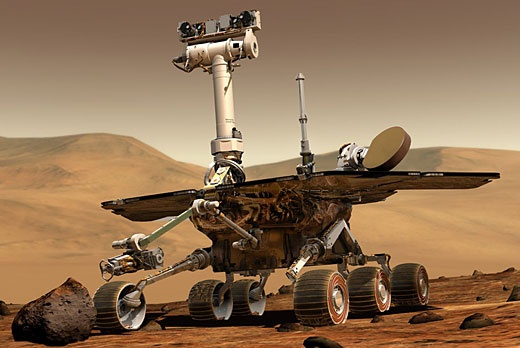SUBHEAD: It’s the fifth anniversary the Mars mission of “Spirit” and “Opportunity”
by Juan Wilson on 3 January 2009 for Island Breath -
(http://islandbreath.blogspot.com/2009/01/mars-rovers-fifth-anniversary.html)
 Image above: Computer generated image by NASA of Mars Rover exploring.
Image above: Computer generated image by NASA of Mars Rover exploring.

One of the first articles on IslandBreath.org was one noting the landing on Mars of the two Rover mission solar powered robots. There was worry at the time that NASA had lost contact with the rover "Spirit".
Many might feel, reading this website, that I am a Luddite and do not support or respect technology of the space program. Actually, I was an enthusiastic supported of NASA's space program and eye-witnessed the Apollo 11 takeoff that landed the first men on the moon. At that time, 1969, the plan was to land men on Mars by 1990.
But people quickly tired of the bleak, gray, dead, landscape of the Moon and lost the their stomach for space exploration. President Richard Nixon helped convince the American people that what they needed was not another spaceship, but the Shuttle program. The Shuttle was billed as a re-usable ship that would build the space platform to reach Mars.
In my opinion the Shuttle program has been a dangerous and pathetic failure. The manned space program is history. The Untied States could not build another spaceship to reach the moon if it wanted to. The engineers, plants, jigs and dies needed to put together a Saturn Five rocket capable of reaching our nearest neighbor don't exist.
We are left with a sub-orbital rocket plane so dangerous we dare not risk sending any beloved citizen aloft in it.
In 1998 the always foolish Jerry Bruckheimer produced a movie titled "Armageddon" that starred Bruce Willis as a Shuttle jockey on a mission into deep space to save the Earth from an approaching asteroid. This required shooting off into deep space, landing the Shuttle on the approaching asteroid. Drilling several deep holes into its surface, inserting timed nuclear devices, rocketing away from the asteroid before the detonations engulfs the ship and and returning to earth. Wow!
This in reality would be an impossible task for the Shuttle so in the movie it was "modified as required". It is amazing how little idea most Americans about what their technology can and cannot do.

Image above: Poster promoting Jerry Bruckheimer movie "Armageddon" featuring NASA Shuttle in deep space.
That is all the more reason to be impressed when something like the Mars Rovers work so well, for so long with so little investment.
As Joyce Gramza noted in an article titled "Tenacious Twins" on www.ScienceCentral.com
"As the twin rovers emerge intact from yet another Martian winter, lead scientist Steve Squyres reflects on the incredible milestone, and the future.
The twin Mars Exploration Rovers “Spirit” and “Opportunity” landed in January 2004 with the mission of exploring Mars for three months. As the years passed we may have begun to take them for granted, but they’ve never ceased to amaze lead scientist Steve Squyres.
“The previous landings on Mars– there had been three: two Vikings and Pathfinder — all involved stationary landers, they couldn’t go anywhere,” Squyres recalled. “And what we wanted to do was to explore in the truest sense of that word.” That meant giving the robots wheels to travel, camera eyes to see and computer brains to record and communicate – as well as some toolsgeologists would want along.
After the landings, the biggest challenge continues to be the threat ofMartian dust coating their solar power supplies.
The Rovers weathered severe dust storms in July, and are now poised to weather yet another Martian winter. The rover operations teams have driven both rovers to northward-facing slopes to maximize the winter sunlight falling on their solar panels.
Both rovers accomplished the mission of finding evidence of water on Mars within their allotted 90 days, then soldiered on to make more surprising discoveries. Recently, Spirit even capitalized on its dragging right wheelby analyzing the soil it turned up, providing new evidence that Mars may have once harbored life.
While relying on smart maneuvering, conservation and a certain amount of good luck, Squyres learned to accept the missions’ successes while anticipating their eventual end.
“There’s always going to be some tantalizing thing just beyond our reach that we didn’t quite get to,” he said. “And that’s, I guess, the nature of exploration and so we just live with it.”
NASA has extended the rovers’ missions five times, most recently in October, 2007.
“We’re going to keep operating these vehicles until they drop dead,” said Squyres. “And that could be days, weeks, years, I have no idea.”
That is all the more reason to be impressed when something like the Mars Rovers work so well, for so long with so little investment.
As Joyce Gramza noted in an article titled "Tenacious Twins" on www.ScienceCentral.com
"As the twin rovers emerge intact from yet another Martian winter, lead scientist Steve Squyres reflects on the incredible milestone, and the future.
The twin Mars Exploration Rovers “Spirit” and “Opportunity” landed in January 2004 with the mission of exploring Mars for three months. As the years passed we may have begun to take them for granted, but they’ve never ceased to amaze lead scientist Steve Squyres.
“The previous landings on Mars– there had been three: two Vikings and Pathfinder — all involved stationary landers, they couldn’t go anywhere,” Squyres recalled. “And what we wanted to do was to explore in the truest sense of that word.” That meant giving the robots wheels to travel, camera eyes to see and computer brains to record and communicate – as well as some toolsgeologists would want along.
After the landings, the biggest challenge continues to be the threat ofMartian dust coating their solar power supplies.
The Rovers weathered severe dust storms in July, and are now poised to weather yet another Martian winter. The rover operations teams have driven both rovers to northward-facing slopes to maximize the winter sunlight falling on their solar panels.
Both rovers accomplished the mission of finding evidence of water on Mars within their allotted 90 days, then soldiered on to make more surprising discoveries. Recently, Spirit even capitalized on its dragging right wheelby analyzing the soil it turned up, providing new evidence that Mars may have once harbored life.
While relying on smart maneuvering, conservation and a certain amount of good luck, Squyres learned to accept the missions’ successes while anticipating their eventual end.
“There’s always going to be some tantalizing thing just beyond our reach that we didn’t quite get to,” he said. “And that’s, I guess, the nature of exploration and so we just live with it.”
NASA has extended the rovers’ missions five times, most recently in October, 2007.
“We’re going to keep operating these vehicles until they drop dead,” said Squyres. “And that could be days, weeks, years, I have no idea.”
Video above: Interview with Steve Squyres, NASA. Produced by Joyce Gramza — Edited by James Eagan.
See also:
Island Breath: Mars Rover Lands 1/9/04
See also:
Island Breath: Mars Rover Lands 1/9/04
2 comments :
I was up at Mauna Kea during the NASA Media day last month, where they showed the new Moon Rover, SCARAB.
The did make mention of going to Mars soon and possibly making living conditions there possible someday.
I meant to leave the link to the pictures:
http://damontucker.wordpress.com/2008/12/23/day-on-mauna-kea-with-nasa-developers-and-the-moon-rover/
Post a Comment